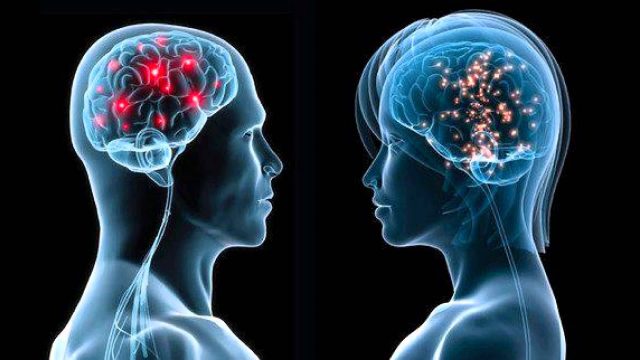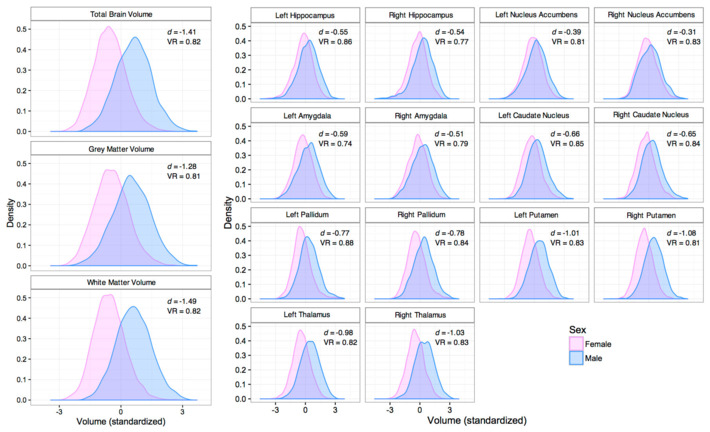Sexual differences in the human brain

Sexual differences in the human brain, both in structure and function, have a high scientific interest and a clear social impact. In the biological part because of the different susceptibility of both sexes to some developmental disorders such as autism —four times more frequent in males than in females—, and also to psychiatric diseases and neurodegenerative disorders such as Alzheimer’s disease, with a higher ratio in females. From the social perspective, there are sexual differences in some psychological trends and behaviors that are unclear if they result from different genetics or from different raising or education. Knowing the sexual differences in the brain anatomy and physiology can help to discriminate between the biological and environmental components of traits that are differentially expressed in men and women. It is also a very politicized topic. There are people who only accept those data that confirm their ideas or fit their prejudices: that the brains of men and women are the same, that they are different, or that the classification is not dichotomous and there are more than two groups. Among the functions that are mostly associated with women is to be more nurturing while men would be more aggressive. Others say that there is no male or female brain and that these distinctions have been only used to support sexist discriminations.
One recent study has focused on the anatomical differences between the brains of men and women 1. It has been published in Biorxiv; thus, it has not been subjected to peer review yet. Eighteen researchers, the first of which is Stuart Ritchie, a postdoctoral researcher at the University of Edinburgh, co-authorize the study. The team analyzed data from more than 5,000 people (N= 5,216) who volunteered to have their brain scanned in what is known as UK Biobank, a national and international health resource with 500,000 participants open to all bona fide health researchers. A main result was that males have higher cortical and sub-cortical volumes, cortical surface areas and white matter diffusion directionality; females have thicker cortices and higher white matter tract complexity.

By contrast, the conclusion of a previous article published in the Proceedings of the National Academies of Sciences was that male and female brains were virtually identical and that sexual differences in behavior were wholly or almost entirely learned 2. However, when another group of researchers examined the data with which that article was written, they criticize that its method systematically fails to detect large, consistent sex differences and that «brain features correctly predicted subjects’ sex about 69-77% of the time» 3, a higher percentage than could be expected if both groups of brains were identical. In addition, they indicate that the multivariate overlap of female and male distributions based on the same variables was moderate (42% on average) and certainly not so large as to invalidate the idea of overall sex differences in brain structure.
The main ideas of the pre-print paper by Ritchie et al. are as follows 4:
There are many differences between male and female brains but there is also an enormous amount of overlap. That is, the mean volume of male brains is greater than that of female brains, but the great variability within both groups makes it impossible to tell whether a given brain corresponds to a man or a woman.
The different zones also show significant differences, in some cases more pronounced than others, but it is worth mentioning the amygdala, a key area in the processing of emotions, the nucleus accumbens, that is part of the reward circuit, and the hippocampus involved in spatial memory and other functions
One aspect that is always pointed out in this research topic is that men are bigger in general and that explains that we have bigger brains. After making the correction by size, the differences in some areas like the thalamus, hippocampus and caudate disappeared. The modestly higher male score on two cognitive tests was partially mediated via structural differences.
Concerning this topic, Ritchie indicated that it is definitely interesting to ask this question: «Do the male/female size differences in particular areas just reflect something general about how big the brain is, or is there something specific about that area that makes it particularly big/small? But it is also interesting to ask «If you just have a bigger [part x of the brain], does that matter, regardless of how large your overall brain is? The fact that researchers do not know what differences have any functional meaning indicates how long is still the way to go in this field.
Apart from the interest in the debate in the society, these variations can help to explain some disorders and diseases that have to affect differently to both sexes. The reason for this different susceptibility is something that in most cases is not known.
The last point is that it is very premature to come to conclusions about whether differences in brain size explain some differences in behavior between the sexes. An important fact is that the intensely used brain zones increase in size. It is famous the research where was shown that the hippocampus, the brain zone fundamental for the spatial memory necessary to remember the map of the enormous city and to know how to take the clients to their destination by the most suitable route, was larger in cab drivers than in controls. In that sense, if men had bigger the brain areas related to aggressiveness than women could be due to years of a more aggressive behavior, and not necessarily the reverse.
New advances are expected in the coming months. The brain image database of the UK Biobank will soon reach the size of 100,000. Once with much more solid anatomical data it will be possible to try to discriminate between the genetic and environmental aspects of the owners of all those brains and try to see if men and women brains really differ. Up to know, the jury is still out.
References
- Ritchie SJ, Cox SR, Shen X, Lombardo MV, Reus LM, Alloza C, Harris MA, Alderson HL, Hunter S, Neilson E, Liewald DCM, Auyeung B, Whalley HC, Lawrie SM, Gale CR, Bastin ME, McIntosh AM, Deary IJ (2017) Sex differences in the adult human brain: Evidence from 5,216 UK Biobank participants ↩
- Joel D, Berman Z, Tavor I, Wexler N, Gaber O, Stein Y, Shefi N, Pool J, Urchs S, Margulies DS, Liem F, Hänggi J, Jäncke L, Assaf Y (2015) Sex beyond the genitalia: The human brain mosaic. Proc Natl Acad Sci U S A. 2015 Dec 15;112(50):15468-73 ↩
- Del Giudice M, Lippa RA, Puts DA, Bailey DH, Bailey JM, Schmitt DP (2016) Joel et al.’s method systematically fails to detect large, consistent sex differences. Proc Natl Acad Sci U S A. 113(14): E1965 ↩
- Singal J (2017) Here’s the Biggest Study Yet on the Differences Between Male and Female Brains. Science of Us. ↩
1 comment
[…] lie in reproduction, not in temperament or in cognitive abilities. The neuroscience of the brain shows that there is a lot of overlap and a few differences between male and female brains, yet that, […]